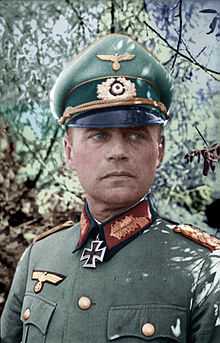Ferdinand Heim
| Ferdinand Heim | |
|---|---|
 | |
| Born |
27 February 1895 Reutlingen, German Empire |
| Died |
14 November 1971 (aged 76) Ulm, West Germany |
| Allegiance |
|
| Service/branch | Heer |
| Years of service | 1914–45 |
| Rank | Generalleutnant |
| Commands held |
14th Panzer Division 48th Panzer Corps Boulogne fortress garrison |
| Battles/wars |
World War I World War II - Fortress Boulougne |
| Awards | Knight's Cross of the Iron Cross |
Ferdinand Heim (27 February 1895—14 November 1971) was a World War II German general.
War service
Heim served as a junior artillery officer in the XIII Corps during the whole of the First World War[1] After 1918 he remained in the much smaller army as a career officer, reaching the rank of Oberst in June 1939, just before the start of the Second World War.
On September 3, 1940, Heim was appointed Chief of Staff to General Walther von Reichenau while the Sixth Army was concentrated on the Cotentin Peninsula awaiting the Invasion of Britain. He was subsequently prominent in the planning of the German invasion of the Soviet Union (Operation Barbarossa).[2]
On 1 July 1942, he was Commander of the 14th Panzer Division with distinction at Kharkov and at Rostov. As a consequence, he was given, on November 1, 1942, command of 48th Panzer Corps which was then part of the German 6th Army, at Stalingrad. Heim's role was to reinforce the Romanian divisions in the area. Heim is particularly noted as being the "scapegoat of Stalingrad". Adolf Hitler, had (against the prevalent advice of Army commanders) ordered the Stalingrad campaign and subsequently refused to permit withdrawal. Consequently, the 6th Army was surrounded by Russian forces at Stalingrad. Heim's 48th Panzer Corps, at Kalach-na-Donu on the Don, with two under-strength Panzer Divisions and a poorly equipped Romanian Panzer Division and with orders countermanded by Hitler,[3] had failed to stop the formidable Russian attack against the Romanian Army which covered the Sixth Army's left flank. After this, in January 1943, Heim was, at Hitler's order, dismissed from the Army, arrested and placed in solitary confinement at Moabit, finally being released in April 1943, when he was transferred to a military hospital at Ulm.[2]
In a post-war interview, Heim asserted that the only documentation for his arrest was Hitler's order – no indictment, sentence or explanation. He learned, unofficially, that Hitler had been unwilling to cast blame on the Romanians for the poor quality of their troops so a German scapegoat was needed. German army and army group commanders were too valuable, so the "... only person left was the corps commander, and that was me."[2]
Heim was informed in May 1943 that his dismissal from the German army had been revoked, and that he had been classified as retired. In August 1944, Heim returned to command German forces at the "fortress" of Boulogne, a "defend to the last" assignment. He was instructed to prepare significant defences but he arrived to find that nothing had been prepared and there were no suitable specialists to do the work. The ill-prepared and ill-suited garrison endured heavy bombardment and full-scale assaults and Heim surrendered to the 3rd Canadian Infantry Division on 23 September 1944 (see Operation Wellhit).[4]
Post-war
Heim was sent to a series of POW camps (including Island Farm) in Britain and subsequently repatriated to Germany on 12 May 1948.[5] He died at Ulm on 14 November 1971.[6]
Summary of his military career
Dates of rank
- Fahnenjunker-Unteroffizier: October 1914
- Fähnrich: November 10, 1914
- Leutnant: February 25, 1915
- Oberleutnant: October 18, 1918
- Hauptmann: March 1, 1928
- Major: August 1, 1934
- Oberstleutnant: March 1, 1937
- Oberst: August 1, 1939
- Generalmajor: February 1, 1942
- Generalleutnant: November 1, 1942
Notable decorations
- General Honour Decoration for Bravery (Hesse)
- Golden Military Merit Medal (Württemberg)
- Honour Cross of the World War 1914/1918 (1934)
- Wound Badge in Silver (1942)
- Iron Cross Second (1914) and First (1914) Classes
- Clasp to the Iron Cross Second and First Classes
- Knight's Cross (1942)
- German Cross in Gold (26 January 1942)
- Eastern Front Medal
Quote
"We must uphold the principle of only having carried out orders [...] We must stick to that principle if we are to create a more or less effective defence" - spoken in secret while prisoner to his fellow inmates regarding German atrocities in World War II[7]
References
- ↑ http://www.specialcamp11.fsnet.co.uk/Generalleutnant%20Ferdinand%20Heim.htm
- ↑ 2.0 2.1 2.2 Shulman, Milton (1995). Defeat in the West. Chailey, East Sussex: Masquerade. pp. 216–217. ISBN 1-872947-03-4.
- ↑ Beevor, Antony (1998). Stalingrad. London: Penguin Books. p. 244. ISBN 0-14-024985-0.
- ↑ Chant, Christopher (1986). The Encyclopedia of Code Names of World War II. London: Routledge and Kegan Paul. pp. 330–331. ISBN 0-7102-0718-2.
- ↑ "Generalleutnant Ferdinand Heim". Some of the Prisoners held at Special Camp 11. Island Farm. Retrieved 15 June 2009.
- ↑ LEO-BW
- ↑ Roberts, Andrew (21 July 2007). "The Genocide Generals: secret recordings explode the myth they knew nothing about the Holocaust". Daily Mail. Retrieved June 15, 2009.
- The German Army 1939-45 (5) by Nigel Thomas and Stephen Andrew.
External links
| Wikimedia Commons has media related to Ferdinand Heim. |
| Military offices | ||
|---|---|---|
| Preceded by General der Panzertruppen Rudolf Veiel |
Commander of XLVIII Panzer Corps 1 November 1942 – 19 November 1942 |
Succeeded by General der Panzertruppen Hans Cramer |
| |||||||||||||||||||||||||||||||||||||||||||||
|